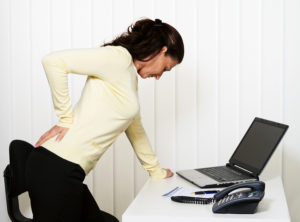Although often interchanged, there is a difference
between a herniated and bulging disc. Discover the
difference and the best course of action for recovering
from both.
What is a disc?
Between each vertebrae in your spine is a cushion
called a intervertebral disc. It is supported by a
system of ligaments that help hold them in place.
Since our backs carry and distribute weight, the discs
are made to absorb shock from the load and movement
of our bodies. This is hard work as we walk, run, bend,
and twist each day.
Over the course of time, the discs become worn out.
A traumatic injury and poor lifestyle choices may
increase the risk for a disc problem. This includes
repeated lifting, participating in sports, obesity,
smoking, and poor posture. All these things
increase break down and push the disc out of it’s
proper place.
Subsequently, it is common for people to come to us
reporting a “slipped disc”. An intervertebral disc
actually doesn’t slip out of place. When you hear this
phrase, realize that you actually have a bulging or
herniated disc.
But, what’s the difference between the two?
Bulging Disc
When a disc bulges, the outer layer pushes out fairly
evenly all the way around. It looks a little like a
hamburger that’s too big for its bun. At this point, the
disc is not “herniated” but this is often a precursor.
Herniated Disc
A herniated disk, on the other hand, results when a
crack in the tough outer layer of the disc allows some
of the softer inner cartilage to protrude out of the disc.
This is like a jelly donut that’s losing it’s filling.
A herniated disc is more likely to cause pain. The
irritation can be from actual compression of the nerve
or more commonly a painful inflammation of the nerve
root. Symptoms of a herniated disc may include
muscle spasm, cramping, weakness, tingling, or pain
referred down the arm or leg.
Why neither may be the cause of your pain?
The pain from a bulging or herniated disc can make it
difficult to participate in every day activities such as
walking, sitting, or even sleeping comfortably. People
are often limited in their activities of enjoyment such
as sports, gardening, or travel.
When seeking medical guidance for this pain, patient’s
are often sent for diagnostic imaging such as MRIs or
CT scans. However, if an imaging test indicates you
have a disc problem, the disc may not actually be the
cause of your back pain.
In fact, many people have MRI evidence of a herniated
disc and have no back pain at all. A study was
performed on individuals 60 years and older who had
no symptoms of back pain and found 36% had a
herniated disc and over 90% had degeneration or bulging
of the discs. So, even if it is found your disc is bulging
or herniated, pain only occurs if it’s pressing on a spinal
nerve or the spinal cord.
What about treatment options?
Researchers found that these people who were initially
sent for MRIs, over conservative care, ultimately paid
more for their treatment. They were also more likely
to have surgery or injections compared to those who
first went to physical therapy.
A study conducted at Thomas Jefferson University
Hospital in 2013 found that patient’s that underwent
back surgery did not demonstrate a significant
difference in outcomes measures such as pain, health
status, satisfaction, or disability compared to
nonoperative treatments.
In fact, in all but extreme cases, a course of
noninvasive care by a physical therapist produces
better long term results than injections or prescription
medications. Additionally, these individuals reached
their goals without the negative side effects associated
with medications such as addictive opioids.
I bet that MRI doesn’t sound like such a great idea
anymore.
If you are interested in back pain treatment options
you can start TODAY from HOME for FREE.
This report will help guide you:
“7 Solutions to End Back Pain without Medications,
Injections, Special Tests, or Referrals”
Are your ready to discuss what conservative
treatment options a physical therapist could provide
for your back pain?
Go HERE and request a FREE “Discovery Visit” where
we can identify the root cause of your pain and let you
know if physical therapy will be your most effective
course of action.
Our goal is to eliminate your pain, guide you in
returning to normal daily activities and recreation, as
well as preventing future back injuries.




